#marie d'orléans
Text
Anne of Austria and Mazarin: a more nuanced reading.
The question of the queen mother’s relationship with Mazarin has been the stuff of historical speculation since the mazarinades first spread notions of illicit sexual relations, secret marriage, and the cardinal’s ‘bewitching’ of the queen. Since then, slightly more decorous historical discussion has sought to establish the nature of the relationship, with the obvious underlying question of how emotionally dependent Anne was on Mazarin. Much of this relies on reading meanings into letters from Mazarin to Anne whose tone and expression could encompass the possibilities of frustrated physical passion, heightened seventeenth-century notions of sentiment and friendship, calculated emotional manipulation, and a great deal in between these three. The relevant question in this context is whether the queen mother could contemplate abandoning Mazarin and leaving him in permanent exile, either because the emotional ties were less strong than Mazarin wished to believe, or because Anne calculated, on behalf of her son, that the political price —or political risk— of restoring the cardinal was too high. Here the only real source, given the queen’s own silence, are the memoirs of contemporaries around her at court, and opinions in these are divided. If some of these writers assert that Anne would never abandon Mazarin, others were quite prepared to argue that the queen’s affections were conditional and perceptibly diminishing as Mazarin’s absence continued. A third group did not doubt Anne’s affection for the cardinal, but were more sceptical of her resolution and commitment to him in the face of persuasion and contrary arguments advanced by those in her entourage and in the council.
Some of the shrewdest commentary can be found in the memoirs of Marie d’Orléans, duchesse de Nemours, who was not an intimate of Anne like Mme de Motteville, but no enemy of the queen either. Nemours’ memoirs assert that commentators had been so obsessed with the notion that the queen was entirely controlled by Mazarin that they had failed to note just how little correspondence there was between the two of them, and the amount of mutual misunderstanding that grew up during Mazarin’s exile. The queen mother, she argued, had little taste for the work of government and little confidence that she could handle it well; despite this, Nemours adds, she had a good sense of political judgement based on scepticism about the motives of everyone. So it suited the queen to allow Mazarin to take responsibility for government, but when he was not present she was prepared to take the advice of others around her, even when this cut across the actions and policies that she had previously agreed with the cardinal. This interpretation of the queen’s motivation was not good news for Mazarin’s aim to shape Anne’s actions on the basis of his intermittent correspondence. And it was echoed by two of Mazarin’s strongest advocates at court: his nephew by marriage, the duc de Mercoeur, and his military ally, the maréchal du Plessis-Praslin. Both stressed that the queen was, in Mercoeur’s words, ‘susceptible to being pressured’ by those ministers and courtiers with whom she was more immediately in contact.
These pessimistic judgements were not fully accepted by Mazarin, but he was certainly concerned that Anne might get used to managing affairs of state without him. It was not possible to insulate the queen mother from those around her, and many of them were either his undeclared enemies or those who believed that Mazarin’s return would complicate an already precarious political situation. His response, as we have seen, was to keep his return as the unremitting focus of all his letters, while simultaneously expecting his allies and appointees in the council and at court to maintain the pressure on the queen by stressing the miseries of his exile and the benefits that would be brought by his presence.
All of this took its toll: Mazarin was prepared to confront the queen directly about the extent of her commitment to him, and his replies suggest that he received some written reassurances from Anne in return. But he was no less aware that even the most detailed and painstakingly written account of the political situation and the role she should play was less immediately influential than direct conversation with the queen. Unless he could count on those around Anne to remain ‘on message’, his letters could easily be forgotten; and many of these courtiers saw Mazarin’s stock as having fallen to the point where his concerns could be ignored with impunity. An additional hazard in trying to build up a group of cheerleaders around the queen came from Anne’s suspicions that Mazarin’s letters to others in the court circle may have offered different perspectives and information from those sent to her personally. The duc de Mercoeur explained in a letter to Mazarin that the queen insisted that all those at the court who received letters from Mazarin should read them out to her in her apartments. Mercoeur recognized that this had the potential to embarrass Mazarin, if not worse, and suggested that the cardinal should send information that he did not want disclosed to the queen in separate, additional notes that could be kept apart from the letter for public consumption.
David Parrott - 1652: The Cardinal, the Prince, and the Crisis of the Fronde
#xvii#david parrott#1652: the cardinal the prince and the crisis of the fronde#cardinal mazarin#anne d'autriche#marie d'orléans#madame de motteville#duc de mercoeur#maréchal du plessis-praslin
3 notes
·
View notes
Text

Marie-Amélie, Queen of the French (1782-1866) wife of Louis-Philippe I (1773-1850). By Frédéric Millet.
#Frédéric Millet#royaume de france#maison d'orléans#bourbon orleans#marie amelie#borbone di napoli#casa di borbone#borbone delle due sicilie#kingdom of france#house of bourbon#royalty
74 notes
·
View notes
Text

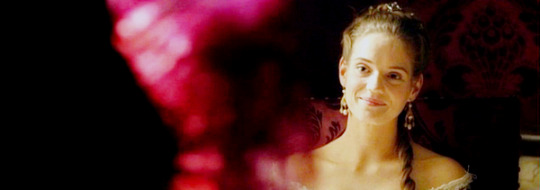





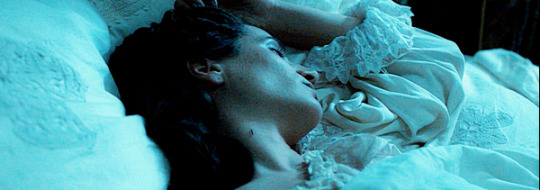


@perioddramasource: PERIOD DRAMA APPRECIATION WEEK
Day Two: Favourite Period Drama TV - Versailles (created by Simon Mirren and David Wolstencroft)
#versailles tv#versaillesedit#perioddramaedit#perioddramaweek2023#noemie schmidt#george blagden#alexander vlahos#evan williams#anna brewster#elisa lasowalski#jessica clark#frances pooley#catherine walker#my edits#heniette d'angleterre#louis xvi#phillipe d'orléans#chevalier de lorraine#madame de montespan#marie thérèse#liselotte von der pfalz#marie louise#madam de maintenon
158 notes
·
View notes
Text

Portrait of Anne of Austria (1601-1666), wife of Louis XIII of France.
It’s probably a depiction of Anne Marie Louise d'Orléans (1627-1693), granddaughter of Henry IV of France. Circle of Charles Beaubrun.
#royaume de france#maison de bourbon#anne d'autriche#reine de france#vive la reine#anne marie louise d'orléans#duchesse de montpensier#la grande mademoiselle#maison d'orléans#bourbon orleans#charles beaubrun
5 notes
·
View notes
Text
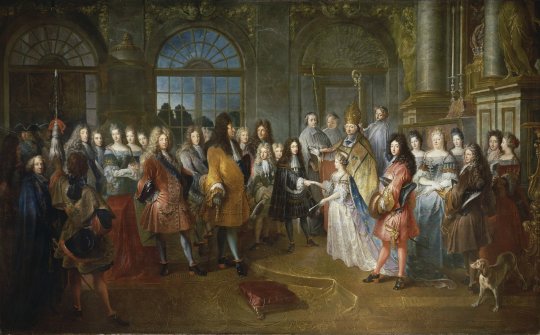
The marriage of the Duke of Burgundy to Marie Adelaïde of Savoy on December 7 1697 by Antoine Dieu.
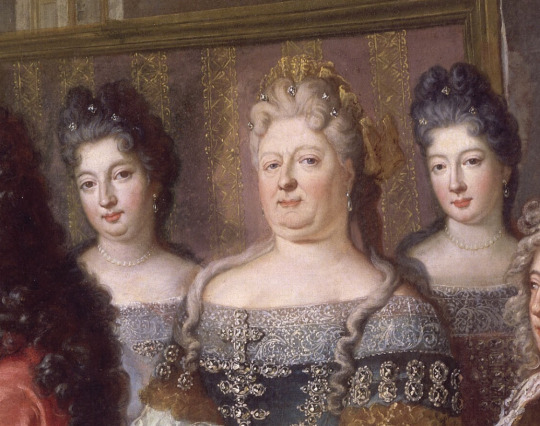
#visual#felipe v de españa#philippe duc d'anjou#philip v of spain#louis duc de bourgogne#le petit dauphin#charles duc de berry#bourbon#bourbon-anjou#louis xiv#philippe duc d'orléans#philippe d'orléans#louis de france#le grand dauphin#marie adelaïde of savoy#bourbon-orléans
3 notes
·
View notes
Note
What do you think of Chartres in the drama Marie Antoinette?
So, I still haven't watched the show, so I want that on the record. My opinions are formed purely based off of what I'm hearing; if you ask me after I have the time to watch the whole thing, you might get a very different opinion out of me.
That being said. Well. The lovely thing about being a Philippe fan is that you get used to...everything. Like, I'm totally numb at this point. I read Innocent, there's nothing that can shock me as far as Philippe portrayals. It's physically impossible to shock me, I've seen it all. Every horrible thing you can imagine Philippe doing, I've seen him do on either page or screen, which is impressive when you consider that he doesn't get that many media portrayals.
(VERY long discussion incoming where I touch on rape and rape culture, underage sex, and sexual harassment. Fun times.)
But. Well. It's more of the same, isn't it? The Duc d'Inceléans is upset when the woman he is obsessed with rejects him, throws a tantrum, and joins the revolutionaries, going fully Frollo on her. I wish that people would stop resorting to cheap drama re: him and Antoinette -- their dynamic was so much more complex than just obsession and lust. It was the sort of relationship where...you desperately WISH that things could have been different between them, that they could have remained friends, or reconciled after their falling out, that she could have negotiated a truce between him and Louis before things got so ugly, but you also know that their natures just...they were both strikingly alike in the worst ways (and both of them would HATE that I'm saying this now.) When they were young, that similarity drew them to one another -- they were both young people who didn't really care for convention, with a taste for excitement and balls and parties.
But then they got older, they got more jaded, and that similarity came back to bite them hard in that neither one of them were of a particularly forgiving temperament. They were both loyal to the people who they were close to, even in defiance of any sense of propriety. If you were in their inner circle, you were *in*. But if you did something to ruin that trust, you wouldn't be forgiven. And, as they got older, and the Revolution ate away at them, that paranoia, it became much easier to commit an unforgiveable slight. (Would Orléans, at the beginning of the Revolution, have had an argument with Grace Dalrymple Elliot that left both of them distressed? Would he have tossed his wife out of Palais Royal with only the clothes on her back? Would Antoinette have had a falling out with the Comte d'Artois, her friend since her first days at court? Would she have been heard commenting on her frustration with the émigres? It isn't to say that either of them were even entirely WRONG, or that these things wouldn't have annoyed them...though Orléans snapped harder as time went on, see above re: his wife...rather that things that might have led to a minor tiff a few years back led to friendship destroying falling outs in 1792-1793.) There came a certain point, probably after Ouessant though definitely by 1787-1788, where they'd just hit a point of no return with one another. They'd circle around one another, toy with the idea of playing nice, but they just...couldn't. It wasn't in their natures, even if it was in their own best interests.
And I don't want to be a fatalist, but a part of me wonders if they weren't kind of destined to be at odds. Orléans was born into having an uneasy relationship with Antoinette's husband, who she did love. He'd have always been a revolutionary at heart -- Even had he been on good terms with her and Louis, something tells me he'd have always taken up with the Revolution, even though spite was absolutely a factor in his part there. The thing that you get the feeling of with Philippe is that...he had compassion. We have stories of him pulling his valet from the water when he nearly drowned, of going into mines to see the circumstances the miners were working in, of him, even as a child, giving money to veterans and the poor. And he wasn't a man to sit on the sidelines and stick to the proscribed ideas of aristocratic charity. If there's one word I associate with Philippe, it's *action*. Not political action, which he failed miserably in, as Mirabeau complained bitterly about when Philippe left for England and basically sabotaged his own chance for success, but physical action. The man HAD to be on the spot, he had to be doing something. It wasn't in his nature to lounge around. In some ways, he never gave up being the Duc d'Orléans, don't get me wrong on that -- he was a man who was very used to having certain privileges due to his station. But I also don't think that he would have sat by during the Revolution.
And what I'm getting at here is that the show doesn't get into any of that. Instead, we get an attempted sexual assault. Because Antoinette hasn't had enough of that in this show. I've noticed that people often want Antoinette to have endured more trauma than she actually did historically -- it's bizarrely common to have her be sexually assaulted and...look. The woman was already under enormous pressure to have sex at 14-15 years old, in a foreign country, without her family around her. She was subjected to public mockery, constantly surrounded by people scheming against her and who were willing to find fault with her for the slightest breach of etiquette. She lost two children, had a miscarriage, watched her remaining children being taken away, and that's before you get into her actual imprisonment. It isn't to say she's a martyr, it isn't to say she's a saint, but it is to say that her life doesn't need more trauma. Why do we keep insisting that we need to see her be raped, harassed, or assaulted on camera in order to get that Her Life Occasionally Sucked? It's cheap, it's voyeuristic, and it does her and Philippe both a disservice.
Would Philippe have gone for Antoinette? I don't know. There was about a seven year or so age gap between them. When Antoinette came to Versailles, he'd have been about 21-22 to her 14. During their falling out over Ouessant, she was 23, he was 30. Agnes du Buffon became Philippe's mistress when she was 26; de Genlis about 27; Elliott about 30. The man seemed to prefer, at least for steady mistresses as opposed to brief flings, intelligent, well-read women who were at least in their mid-twenties. He didn't like young girls. Not to say he couldn't surprise me; I try to always work with him with the understanding that he lived two hundred fifty years ago -- He's not my friend, I don't know him. But from the pattern...I'd say no.
Madame Campan had this to say about their dynamic:

[transcript: "The Duc d'Orléans, then Duc de Chartres, was among those who accompanied the young Queen in her nocturnal ramble: he appeared very attentive to her at this epoch; but it was the only moment of his life in which there was any advance towards intimacy between the Queen and himself. The King disliked the character of the Duc de Chartres, and the Queen always excluded him from her private society. It is therefore without the slightest foundation that some writers have attributed to feelings of jealousy or wounded self-love the hatred which he displayed towards the Queen during the latter years of their existence.]
She had no reason to lie and every reason to make Philippe as horrible as could be (and didn't hold off on ripping, for example, Lauzon.) Why hold back? If Philippe had ever behaved improperly, why not write it down?
One time where do see him in a case where a woman turned him down was with Moll Benwell, where we see:

[Transcript: The Duc de Chartres has made himself extremely ridiculous on her account, following her to all public places; to the contempt with which she treats him and his promises (which that nobleman is but too apt to make) she may attribute his constant attendance on her]
(From: An Infamous Mistress: The Life, Loves and Family of the Celebrated Grace Dalrymple Elliott)
He followed her around pathetically, which would have to have been annoying. I wish we knew more of her perspective on this sort of thing. But this is...relatively par for the expected course of behavior. See also: the romantic treatment of Artois' stalking of Louise de Polastron, which appears to have been an innovation of her cousin's reminisces because according to Artois' own correspondence, she was his mistress by 1789. This was an expected part of courtship in the 18th century, there was an idea of how far you could and couldn't go, and Philippe seems to have stuck to that. (The entire thing reminds me of Baby It's Cold Outside Discourse, where someone once said something like "in a society where you can't say openly say yes, you also can't say no.") The memoirs of Leonard, ostensibly by Marie Antoinette's hairdresser, show him having a thing for Rose Bertin and being aggressive towards her -- that book was published eighteen years after Leonard's death and its authenticity has been widely called into question. Am I saying it's impossible? Absolutely not. Philippe was a powerful man. It'd be very easy to develop a sense of entitlement. If any solid evidence comes up, I won't defend him. What I AM saying is that there is no evidence of it when both sides of the Revolution, at varying times, wanted every ounce of dirt they could get on him. (Unlike with Danton, where Elisabeth de Bas admitted that he had preyed on her.)
It's just...it's cheap. People want Philippe to be a Villain™ but they don't want to put the effort in to explain how he becomes one or how his villainy functions, so they just make him a misogynistic incel and call it a day.
3 notes
·
View notes
Text

#Portrait of Anne-Marie-Louise d'Orléans#Duchess of Montpensier#known as the Grande Mademoiselle (1627-1693)
1 note
·
View note
Text
Today's random fanfiction is from the L'Échange des princesses | The Royal Exchange (2017) fandom. Rien à voir. by AngelicaR2
Chapters: 1/1
Words: 336
Fandom: 18th Century CE RPF, L’Échange des princesses | The Royal Exchange (2017)
Rating: General Audiences
Warnings: No Archive Warnings Apply
Relationships: Mme de Ventadour & Marie Anne Victoire d'Espagne
Characters: Mme de Ventadour, Marie Anne Victoire d'Espagne, Louis XV de France, Louise-Élisabeth d'Orléans
Additional Tags: Spain, Versailles - Freeform, 18th Century, Drabble, Hope, Travel, differences
Language: Français
Summary: [L’Échange des princesses] : Drabble. “Marie Anne Victoire n'a rien à voir avec Louise-Elizabeth, et Mme de Ventadour espère sincèrement que cela ne va pas changer.”
#fic rec#random fanfiction#random#random recs#fanfic#ao3#fanfiction recommendation#fanfic rec#fanfiction#ao3 fanfic#18th Century CE RPF#L’Échange des princesses | The Royal Exchange (2017)#Mme de Ventadour & Marie Anne Victoire d'Espagne#Mme de Ventadour#Marie Anne Victoire d'Espagne#Louis XV de France#Louise-Élisabeth d'Orléans#Spain#Versailles - Freeform#18th Century#Drabble#Hope#Travel#differences
1 note
·
View note
Text

1680s-1690s Unknown artist - Portrait of Anne-Marie d'Orléans, Queen of Sardinia
(Private collection)
132 notes
·
View notes
Text

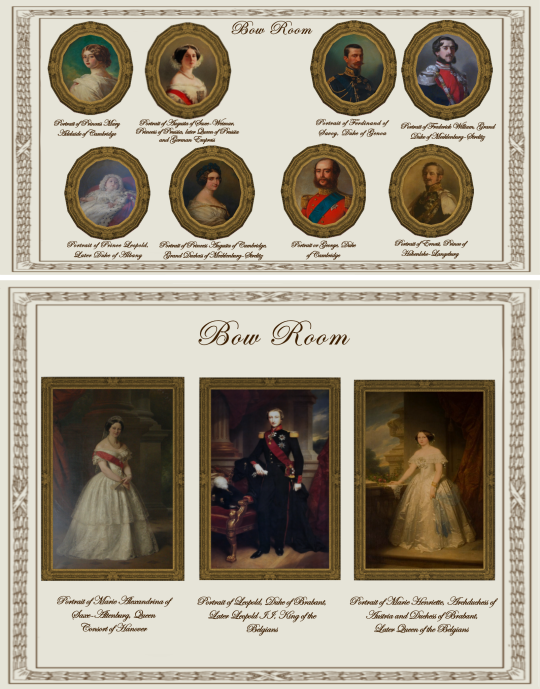
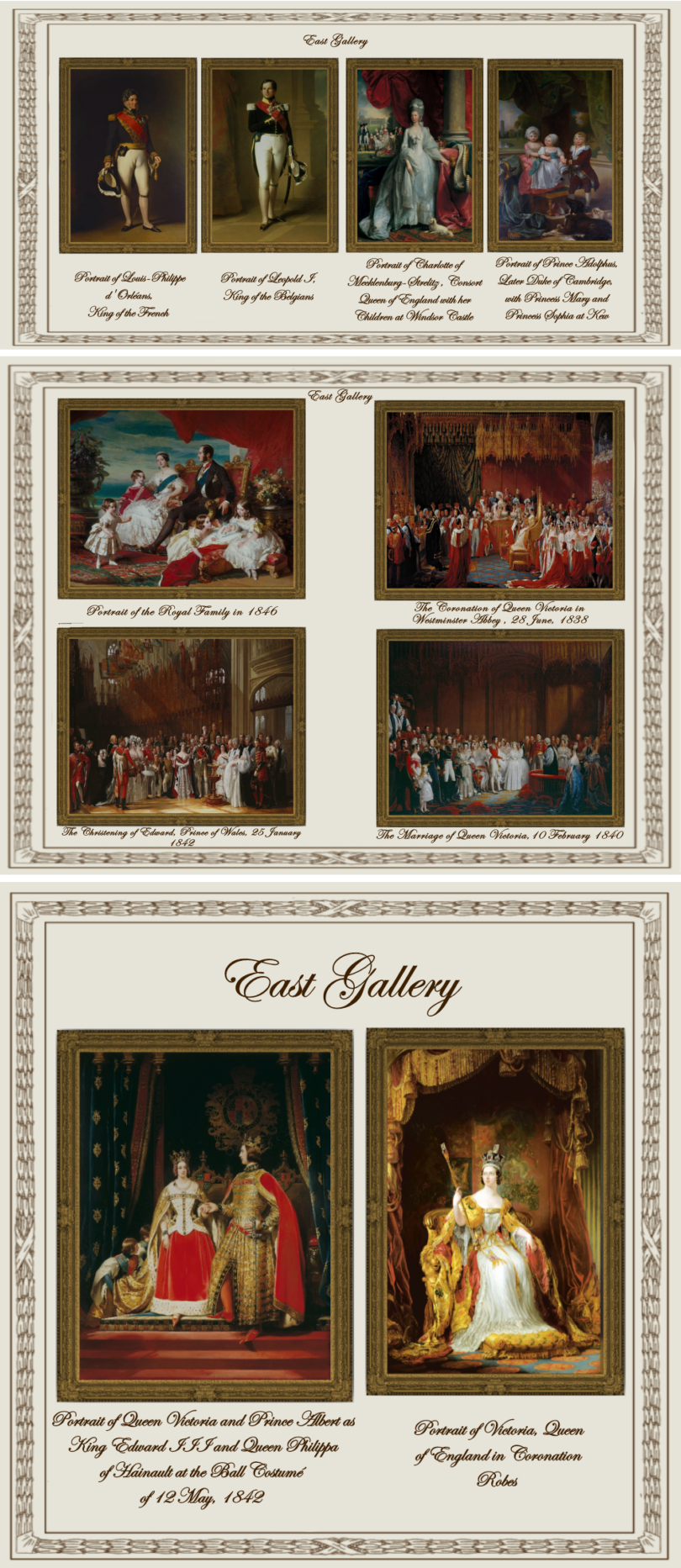
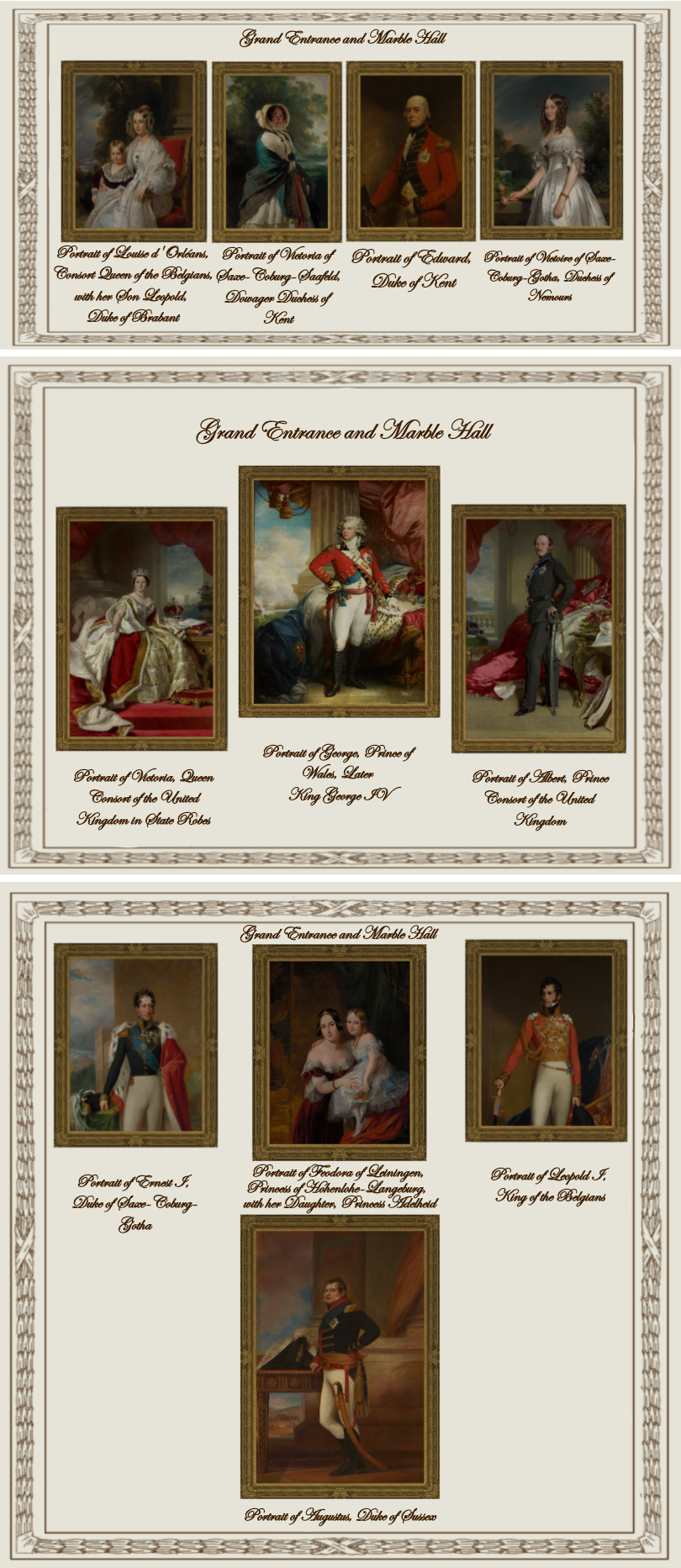

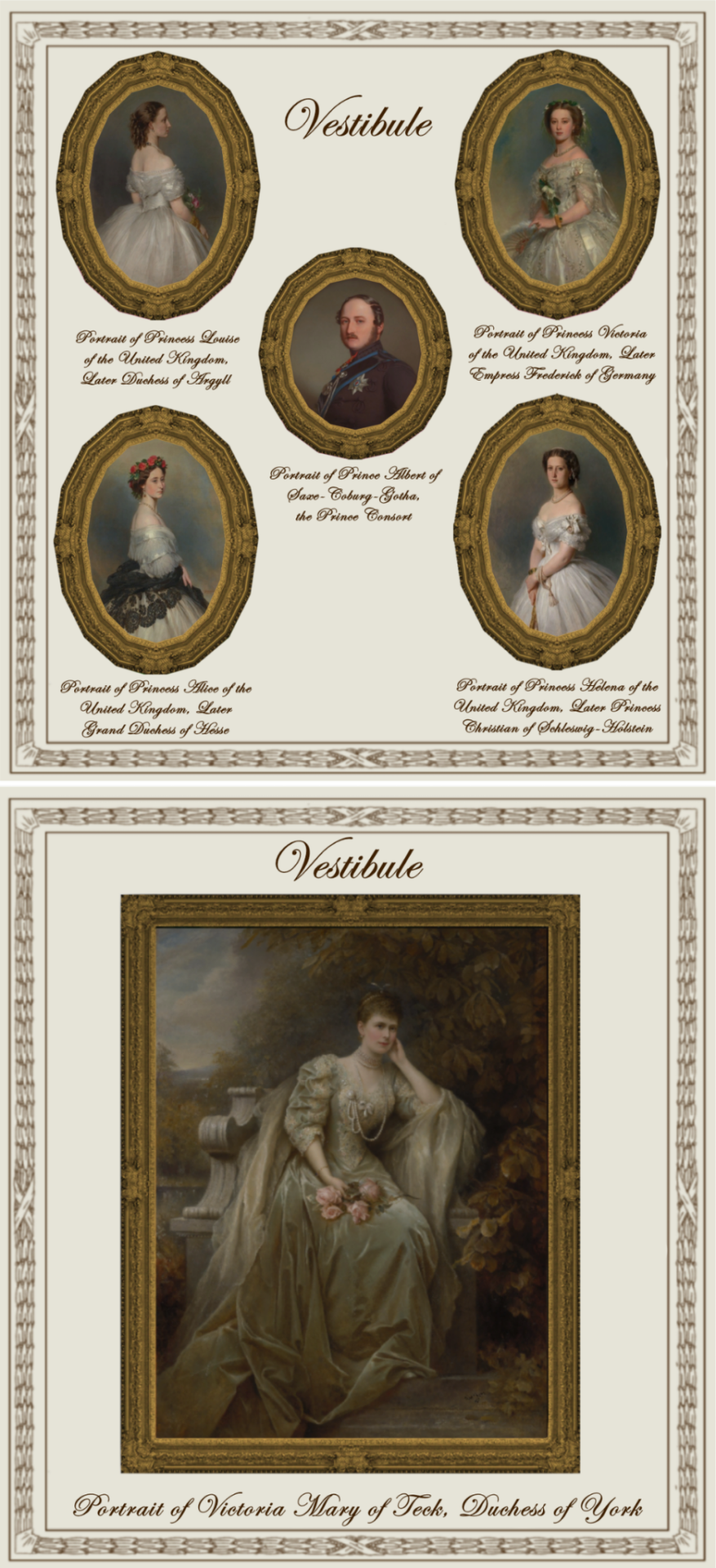


Paintings from Buckingham Palace: part II
A retexture by La Comtesse Zouboff — Original Mesh by @thejim07
Spread among 13 occupied and historic royal residences in the United Kingdom, the collection is owned by King Charles III and overseen by the Royal Collection Trust. The British monarch owns some of the collection in right of the Crown and some as a private individual. It is made up of over one million objects, including 7,000 paintings, over 150,000 works on paper, this including 30,000 watercolours and drawings, and about 450,000 photographs, as well as around 700,000 works of art, including tapestries, furniture, ceramics, textiles, carriages, weapons, armour, jewellery, clocks, musical instruments, tableware, plants, manuscripts, books, and sculptures.
Some of the buildings which house the collection, such as Hampton Court Palace, are open to the public and not lived in by the Royal Family, whilst others, such as Windsor Castle, Kensington Palace and the most remarkable of them, Buckingham Palace are both residences and open to the public.
About 3,000 objects are on loan to museums throughout the world, and many others are lent on a temporary basis to exhibitions.
-------------------------------------------------------
The second part includes paintings displayed in the Ball Supper Room, the Ballroom, the Ballroom Annexe, the Bow Room, the East Gallery, the Grand Entrance and Marble Hall, the Minister's Landing & Staircase, the Vestibule, the Chinese Dining Room and the Balcony Room.
This set contains 57 paintings and tapestries with the original frame swatches, fully recolourable. They are:
Ball Supper Room (BSR):
Portrait of King George III of the United Kingdom (Benjamin West)
Ballroom (BR):
The Story of Jason: The Battle of the Soldiers born of The Serpent's Teeth (the Gobelins)
The Story of Jason: Medea Departs for Athens after Setting Fire to Corinth (the Gobelins)
Ballroom Annexe (BAX):
The Apotheosis of Prince Octavius (Benjamin West)
Bow Room (BWR):
Portrait of Princess Mary Adelaide of Cambridge (William Corden the Younger)
Portrait of Princess Augusta of Cambridge, Grand Duchess of Mecklenburg-Strelitz (Alexander Melville)
Portrait or George, Duke of Cambridge (William Corden the Younger)
Portrait of Frederick William, Grand Duke of Mecklenburg-Strelitz (Franz Xaver Winterhalter)
Portrait of Augusta of Saxe-Weimar, Princess of Prussia, later Queen of Prussia and German Empress (Franz Xaver Winterhalter)
Portrait of Prince Leopold, Later Duke of Albany (Franz Xaver Winterhalter)
Portrait of Ernest, Prince of Hohenlohe-Langeburg (Franz Xaver Winterhalter)
Portrait of Ferdinand of Savoy, Duke of Genoa (Eliseo Sala)
Portrait of Marie Alexandrina of Saxe-Altenburg, Queen Consort of Hanover (Carl Ferdinand Sohn)
Portrait of Leopold, Duke of Brabant, Later Leopold II, King of the Belgians (Nicaise de Keyser)
Portrait of Marie Henriette, Archduchess of Austria and Duchess of Brabant, Later Queen of the Belgians (Nicaise de Keyser)
East Gallery (EG):
Portrait of Leopold I, King of the Belgians (Franz Xaver Winterhalter)
Portrait of Victoria, Queen of England in Coronation Robes (Sir George Hayter)
Portrait of Louis-Philippe d'Orléans, King of the French (Franz Xaver Winterhalter)
Portrait of Charlotte of Mecklenburg-Strelitz, Consort Queen of England with her Children at Windsor Castle (Benjamin West)
Portrait of Prince Adolphus, later Duke of Cambridge, With Princess Mary and Princess Sophia at Kew (Benjamin West)
The Coronation of Queen Victoria in Westminster Abbey, 28 June, 1838. (Sir George Hayter)
The Christening of Edward, Prince of Wales 25 January, 1842 (Sir George Hayter)
The Marriage of Queen Victoria, 10 February, 1840 (Sir George Hayter)
Portrait of the Royal Family in 1846 (Franz Xaver Winterhalter)
Portrait of Queen Victoria and Prince Albert as King Edward III and Queen Philippa of Hainault at the Ball Costumé of 12 May, 1842 (Sir Edwin Landseer)
Grand Entrance and Marble Hall (GEMH):
Portrait of Edward, Duke of Kent (John Hoppner)
Portrait of Ernest I, Duke of Saxe-Coburg-Gotha (George Dawe)
Portrait of Victoria of Saxe-Coburg-Saafeld, Dowager Duchess of Kent (Franz Xaver Winterhalter)
Portrait of Albert, Prince Consort of the United Kingdom (Franz Xaver Winterhalter)
Portrait of Victoria, Queen Consort of the United Kingdom in State Robes (Franz Xaver Winterhalter)
Portrait of Louise d'Orléans, Consort Queen of the Belgians, with her Son Leopold, Duke of Brabant (Franz Xaver Winterhalter)
Portrait of Feodora of Leiningen, Princess of Hohenlohe-Langeburg, with her Daughter, Princess Adelheid (Sir George Hayter)
Portrait of George, Prince of Wales, Later King George IV (Mather Byles Brown)
Portrait of Victoire of Saxe-Coburg-Gotha, Duchess of Nemours (Franz Xaver Winterhalter)
Portrait of Augustus, Duke of Sussex (Domenico Pellegrini)
Portrait of Leopold I, King of the Belgians (William Corden the Younger)
Minister's Landing and Staircase (MLS):
Portrait of George, Prince of Wales in Garther Robes (John Hoppner)
The Loves of the Gods: The Rape of Europa (the Gobelins)
The Loves of the Gods: The Rape of Proserpine (The Gobelins)
Vestibule (VL):
Portrait of Prince Albert of Saxe-Coburg-Gotha, the Prince Consort (Unknown Artist from the German School)
Portrait of Princess Alice of the United Kingdom, Later Grand Duchess of Hesse (Franz Xaver Winterhalter)
Portrait of Princess Helena of the United Kingdom, Later Princess Christian of Schleswig-Holstein (Franz Xaver Winterhalter)
Portrait of Princess Louise of the United Kingdom, Later Duchess of Argyll (Franz Xaver Winterhalter)
Portrait of Princess Victoria of the United Kingdom, Later Empress Frederick of Germany (Franz Xaver Winterhalter)
Portrait of Victoria Mary of Teck, Duchess of York (Edward Hughes)
Chinese Dining Room or Pavilion Breakfast Room(CDR):
Set of Four Painted Chinoiserie Wall panels I (Robert Jones)
Set of Four Painted Chinoiserie Wall panels II (Robert Jones)
Set of Four Painted Chinoiserie Wall panels III (Robert Jones)
Set of Four Painted Chinoiserie Wall panels IV (Robert Jones)
Balcony Room or Centre Room (BR):
Chinoiserie Painted Panel I (Robert Jones)
Chinoiserie Painted Panel II (Robert Jones)
Chinoiserie Painted Panel III (Robert Jones)
Chinoiserie Painted Panel IV (Robert Jones)
EXTRAS! (E):
I decided to add the rest of the tapestries from the story of Jason (wich hangs in the Grand Reception Room at Windsor Castle) and (with Jim's permission) added the original mesh for paintings number 2,3,4 & 5 from the Vestibule (seen here and here) wich was never published. These items are:
The Story of Jason: Jason Pledges his Faith to Medea (the Gobelins)
The Story of Jason: Jason Marries Glauce, Daughter of Creon, King of Thebes (the Gobelins)
The Story of Jason: The Capture of the Golden Fleece (the Gobelins)
The Story of Jason: The Poisoning of Glauce and Creon by Medea's Magic Robe (the Gobelins)
Sea Melodies (Herbert James Draper) (made by TheJim07)
-------------------------------------------------------
Found under decor > paintings for:
500§ (BWR: 1,2,3,4,5,6, & 8 |VL: 1)
570§ (VL: 2,3,4 & 5 |E: 5)
1850§ (GEMH: 1 & 3)
2090§ (GEMH: 2,6,7, 9 & 11)
3560§ (GEMH: 4,5 & 10 |BSR: 1 |EG: 1,2,3,4 & 5 |MLS: 1 |BAX: 1)
3900§ (CDR: 1,2,3 & 4 |BR: 1,2,3 & 4 |EG: 10 |VL: 6 |GEMH: 8)
4470§ (MLS: 2 |E: 1)
6520§ (BR 1 & 2| MLS: 3 |EG: 6,7,8 & 9 |BR: 1 & 2 |E: 2,3 & 4)
Retextured from:
"Saint Mary Magdalene" (BWR: 1,2,3,4,5,6, & 8 |VL: 1) found here.
"Sea Melodies" (VL: 2,3,4 & 5 |E: 5)
"The virgin of the Rosary" (GEMH: 1 & 3) found here.
"Length Portrait of Mrs.D" (GEMH: 4,5 & 10 |BSR: 1 |EG: 1,2,3,4 & 5 |MLS: 1 |BAX: 1) found here
"Portrait of Maria Theresa of Austria and her Son, le Grand Dauphin" (CDR: 1,2,3 & 4 |BR: 1,2,3 & 4 |EG: 10 |VL: 6 |GEMH: 8) found here
"Sacrifice to Jupiter" (MLS: 2 |E: 1) found here
"Vulcan's Forge" (BR 1 & 2| MLS: 3 |EG: 6,7,8 & 9 |BR: 1 & 2 |E: 2,3 & 4) found here
(you can just search for "Buckingham Palace" using the catalog search mod to find the entire set much easier!)
Disclaimer!
Some paintings in the previews look blurry but in the game they're very high definition, it's just because I had to add multiple preview pictures in one picture to be able to upload them all! Also sizes shown in previews are not accurate to the objects' actual sizes in most cases.

Drive
(Sims3pack | Package)
(Useful tags below)
@joojconverts @ts3history @ts3historicalccfinds @deniisu-sims @katsujiiccfinds @gifappels-stuff
-------------------------------------------------------
#the sims 3#ts3#sims 3#s3cc#sims 3 cc#sims 3 download#sims 3 decor#edwardian#victorian#regency#georgian#buckingham#buckingham palace#wall decor#sims 3 free cc#large pack#this was exhausting
60 notes
·
View notes
Text
Geneviève d’Eon & Marie-Jeanne Bertin: Clothing and Gender in 18th Century France
"After being fully dressed by famous designer Rose Bertin for the first time, they ran to their room and cried for hours." ~ Kaz Rowe, The Chevalier d'Eon: the Trans 18th Century Spy
Kaz Rowe throws this story out there in their video on d'Eon as a part of their justification in using they/them pronouns for d'Eon who used she/her pronouns. Rowe never really explains the context for this story. It sounds dramatic on the surface, d'Eon spent hours crying over being forced into women's clothes. But did this really happen?
This story comes from d'Eon's own autobiographical writings that she never finished. Segments of her drafts were translated and published by Roland A. Champagne, Nina Ekstein, and Gary Kates in The Maiden of Tonnerre. The title comes from d'Eon who styled herself la pucelle de Tonnerre after Joan of Arc who was known as la pucelle d'Orléans.
Some things to consider before we start:
D'Eon's autobiographical writings operate under the pretence that she was afab and raised as a boy for inherence reasons. We have to remember that these writings are heavily fictionalised, a necessity in upholding the lie that allowed d'Eon to live as a woman. However that doesn't mean that there is no historical value in these writings. Instead of simply taking these stories as fact we must consider: Why is d'Eon presenting this story in this way? How does this story serve the narrative d'Eon is constructing for herself?
D'Eon in this story claims she had never worn women's clothing before. This is contradicted by d'Eon's own claim of infiltrating the court of Empress Elizabeth of Russia as a woman. While its hard to pinpoint the exact moment d'Eon first wore women's clothes I personally suspect it was much earlier than this.
D'Eon also includes a scene where she is bathed by Bertin's assistants. This scene is almost certainly fictional as if it happened in reality this would reveal that d'Eon had a penis, a fact she wanted to keep secret. This scene is almost certainly included to add to the 'evidence' that d'Eon was afab.
Considering these points we must consider that this story did not take place literally as d'Eon depicts it. Instead of taking this story as an accurate recollection of events I consider it a fictionalised story (based on true events). The goal in my analysis is to ask what is d'Eon trying to communicate though this story.
Some background information to add context:
D'Eon had prior to this incident signed a transaction with Louis XVI in which she was legally acknowledged as a woman and ordered by Louis XVI to wear woman's clothes. D'Eon agreed to "declaring publicly my sex, to my condition being established beyond a doubt, to resume and wear female attire until death," but then adds "unless, taking into consideration my being so long accustomed to appear in uniform, his Majesty will consent, on sufferance only, to my resuming male attire should it become impossible for me to endure the embarrassment of adopting the other". (see D'Eon de Beaumont, his life and times by Alfred Rieu, p174-182 for an English translation of the transaction)
We also must consider that d'Eon did not dispute the fact that she was a woman when signing the transaction, nor does she dispute this in her autobiographical writings. D'Eon was very much arguing that she, as a woman, should be allowed to continue to wear men's clothing (specifically her dragoon uniform) as that is what she was used to wearing and comfortable wearing.
Also mentioned in the following excerpt is the English trial over d'Eon's sex in which it was found that d'Eon was a woman. I'm not going to get too into the topic here as it's a whole other can of worms. However I think it's important to understand that while d'Eon had issues with aspects of the trial she would use the ruling to support her claim that she was afab.
The Maiden of Tonnerre: Chapter VII
Selections from the great interview between Mademoiselle Bertin and Mademoiselle d'Eon in Paris on October 21, 1777
Mademoiselle Bertin. I have come vary early in the morning to spare you trouble and embarrassment. But what else can I do? You must either go through this or through the gates of a convent.
Mademoiselle d'Eon. It is easy to do otherwise. Just leave me as I am. I have lived for forty-eight years this way. I cannot live all that much longer. I am impatiently awaiting the great change that will transform us all making all of us eternally equal.
Mademoiselle Bertin. The Court in its patience will never have the endurance to wait that long. Remember that it was a deliberate error on the part of your father, your mother, and yourself that resulted in Mademoiselle d'Eon's wearing men's clothing and a military uniform. But since that time things have changed considerably, and today by order of King and the law, the bad boy must become a good girl.
It's interesting that here d'Eon has Bertin distinguish between "men's clothing" and "military uniform". As women were not allowed in the French military at this time all French military uniforms were as such men's clothing. But d'Eon did not simply want to wear men's clothing she wanted to wear her military uniform.
Mademoiselle d'Eon. If I was a boy by mistake, one could inadvertently allow me to continue to be one. While you are correct about the substance of the matter, I am not wrong about the form.
Mademoiselle Bertin. That is not possible now. Your trial created too much of a stir.
Mademoiselle d'Eon. I am a reliable bugler in my squadron. I am not frightened by noise. The Court's behaviour, by its very decency, has wound up being indecent. I would have thought that the King would have been willing to allow me to wear the uniform of a former dragoon captain, Knight of Saint Louis, and plenipotentiary minister, since he was kind enough to allow me to wear the cross of the royal and military order of Saint Louis on my dress. Do you see how everything at court is so arbitrary? There one could say every day: Contraria contrariis opponuntur [A contrary opposes other contraries].
Again we see the focus is that d'Eon wanted to wear her dragoon uniform. She likens this directly to her cross of Saint Louis which Louis XVI did permit her to wear on her women's clothes. As the cross of Saint Louis was only awarded to men it is arguably also menswear. D'Eon is pointing out the arbitrary nature of this distinction. Why is she permitted to wear an idem of menswear, the cross of Saint Louis, but not another, her dragoon uniform. To d'Eon these both represent her achievements rather than manhood, she is arguing that she, a woman, should be allowed to wear them.
Mademoiselle Bertin. I concede that every day we see in the streets of Paris a tall young woman in the uniform of a dragoon publicly giving lessons on the use if arms. But remember that this girl was a mere dragoon and that she had no other way to earn a living. To do so, she had written permission to dress as a dragoon form the lieutenant general of the Paris police. But the Court would never grant such permission for a young woman from a good family who had been in France and in foreign courts as Mademoiselle d'Eon has been.
Mademoiselle d'Eon. In a well-regulated country, the law must not allow preferential treatment to anyone.
Mademoiselle Bertin. You can go to Versailles to argue with the Chancellor of France, your former schoolmate. But with Mademoiselle Bertin, it can serve no purpose to argue. Do not take this matter so far as to have a falling out with the King's ministers or the royal Treasury. Remember, Mademoiselle, that in France a maiden who obeys the law and the King must wear her dress and petticoat, whether to remain in this world or to spend her time in the convent.
Mademoiselle d'Eon. Your advice is wise and prudent. I would rather follow you into the royal Treasury than into a convent.
Mademoiselle Bertin. My honorable captain, don't think that you are dishonored by having been found to be a woman. The discomfiture is temporary, and the glory will be with you forever. But let us not wast uselessly the precious time needed to begin and end your outfitting before the return of Major Varville.
Mademoiselle d'Eon. I see that Mademoiselle Bertin is correct about all that she says and does and that a lady-in-waiting to the Queen is thus wiser in her comportment and in her begetting than all the children of the Enlightenment and all the captains of the army.
Without delaying further and having followed the instructions of Mademoiselle Bertin, the Dragoon was, in a short period of time, divested of his serpent's skin and transformed into an angel of light. Her head became as lustrous as the sun. Her whole outlook on things changed as much as did her face. No trace of the dragoon remained in her.
Mademoiselle Bertin thought she was consoling me by saying: "The Queen doesn't despise bravery in a well-born maiden. But out of duty she prefers to find in her decency, honor, and virtue. If Louis XV armed you as a Knight of French soldiers, Louis XVI arms you as a chevalière of French women. And the Queen crowns your wisdom by commanding me to bring to you this new armor, which must accompany your coiffure and your demeanor so that you may become the leading general of all the honorable women of France. The time has come for us to be edified and not scandalized by Mademoiselle d'Eon's conduct. Why don't you offer up your uniform as a sacrifice at Notre Dame de Paris or in your holy anger throw it out the window in order to stand witness before the people of Israel, the Parisians, the Scribes, and the Pharisees that you are now following the letter of the law that Moses gave us in his commandments."
While Mademoiselle Bertin had me get into the bath to be washed, soaped and scrubbed down by her companions, I told her: "Proceed as quickly as possible; do not waste time with the preparations so that I too may keep part of my own dignity as it is joined with yours and that of your seamstresses. Virtuous Bertin, honest messenger form the chamber of the Queen, I fully realize that the hour is at hand for me to follow the directive of the law and the King. As a victim, I am offered up in sacrifice since you do me harm in order to do me good. All women are going to point at me, and all the maidens are going to thumb their noses at me when they see me dressed in style and done up like a doll or at the very least like a Vestal Virgin who is led to the marriage altar."
We see in this excerpt Bertin acts as an authority ushering d'Eon into womanhood, the transformation is painful but ultimately positive for d'Eon; "you do me harm in order to do me good". But there is this real fear of being mocked by other women. At least part of d'Eon's trepidation to don women's clothes comes form the fear of humiliation. We see this fear also reflected in the transaction when she begs King Louis to "consent, on sufferance only, to my resuming male attire should it become impossible for me to endure the embarrassment of adopting the other".
Mademoiselle Bertin. Put aside your concerns about what other will say. Must what the mad say prevent us from being wise?
Mademoiselle d'Eon. Alas, at court everything is beautiful. To please the court, does a former captain have to become a pretty boy [demoiseau]?
Mademoiselle Bertin. Yes, absolutely, when the so-called "boy" is discovered to be in fact a girl by the systems of justice both in England and in France.
Mademoiselle d'Eon. Speaking of justice, is Mademoiselle Bertin, the Queen's servant, also the enforcer of justice?
Mademoiselle Bertin was stung. "Don't be angry," I told her, "I simply wanted you to acknowledge, for you are just in all matters, that I cannot fit into the dress you brought me."
Mademoiselle Bertin remained disconcerted for a moment. But she soon regained her composure and said to me: "If you are a patient girl, the dress that I made for you in the name of Justice will soon be taken out to fit you. And I predict for you that the certainty of happiness will come form the alleged abyss of your unhappiness."
Then, looking pleased with herself, she said to me: "I am glad about having stripped you of your armor and your dragoon skin in order to arm you from head to toe with your dress and finery. In you I have found the power to possess the benefit of simple tonsure without a papal dispensation. Give thanks to God. You can assuredly double your chances of attaining eternal life, for which all of us search amidst this life's sorrows, troubles and suffering. Tomorrow you will suffer less, and the following day you will not suffer at all. In a little while, you will enjoy the relaxation and the joy that are the natural prerogatives of a Catholic girl who loyally follows the breviary of Rome and Paris, which was annotated, revised, and made available to the Daughters of Holy Mary and the Queen's women. You are not yet canonized, but soon you will be beatified when your upcoming marriage is canonically approved. Better this for you than a cannon shot."
D'Eon at this time was considering joining a convent. Bertin is referring to d'Eon's marriage to Christ.
Mademoiselle d'Eon. You can even say that regarding a hail of cannon shots. ... But when I reflect on my past and present states, I will never have the courage to go out in public dressed as you have me. You have illuminated and brightened me up so much that I dare not look at myself in the mirror that you brought me.
Mademoiselle Bertin. A room is not lit up in order to hide it or to keep it in the dark, but rather it is placed beneath a chandelier so that those who enter can see the light and be edified by your conversion.
Mademoiselle d'Eon. I know that there is nothing hidden that should not be revealed or anything secret that cannot be known. Therefore, I will not seek my own willpower but that of the King who sent you here to Mademoiselle d'Eon to change what is bad into something good. Since he obliges me to choose the best way, it will not be taken away from me. What is worth choosing is worth maintaining. When you came to me, I thought you were bringing me death. Now I go to you in order to be alive, because I am no longer chasing after the false vainglory of the dragoons, but after the solid glory of maidens of pease. I am no longer looking for my own glory. There is another who is seeking it for me and is judging it. This order is the most Christian King following the opinion of his Council and his apostolic Sanhedrin, who grants me glory so that I myself might experience that God's will is perfect, that will of the law is just, the King's will is good, and that of the Queen pleasant, decent, and proper, because the Son of Man came to save what was lost.
After this conversation, I quickly left the room and hurried to my bedroom, where I wept bitterly. Mademoiselle Bertin closely followed me and uselessly proposed both a drink and smelling salts in order to console me. I stopped crying only when my tears naturally dried up. Mademoiselle Bertin, as a crafty member of the Court, took advantage of my weekness by saying: "You are certainly not unaware of the joy experienced by the public in Paris when they heard sung the verses about the Heroine from Tonnerre, which were recently printed and are being sung throughout France."
That was the only thing that calmed me in my distress, for when a heart is not entirely dedicated to God it is partly attached to this world. Only vanity can console such an individual because this world prefers human glory to the divine.
And so that it. Thats the moment that d'Eon "cried for hours" after being dressed by Mademoiselle Bertin. So what is d'Eon trying to communicate to the reader in this excerpt?
"When you came to me, I thought you were bringing me death. Now I go to you in order to be alive" is a key part of d'Eon's speech to Bertin, it mirrors an earlier moment in chapter VI where d'Eon says to Bertin "You have killed my brother the dragoon. That leaves me with a heavy heart." In order for d'Eon to become a woman the man or more precisely the dragoon must be killed. D'Eon tries to hang onto both womanhood and her identity as a dragoon but she isn't allowed to.
She cries in morning for the loss of the dragoon she once was and is only cheered by Bertin reminding her that she is now a Heroine. However the d'Eon who is narrating this story criticises her past self for vanity. We see this thought continued in the next chapter:
There is no doubt that it would have been preferable, for my happiness in this world and my salvation in the one to come, had my investiture taken place forty years earlier, because the dragoon disease is so deeply rooted in me that I greatly fear that our saintly Madame Louise will unite with our holy Archbishop, the good Marquis de l'Hôpital, and his pious spouse to have me put away in a hospital for the incurable.
D'Eon presents her transformation into womanhood at the hands of Mademoiselle Bertin as a painful experience but ultimately a necessary and good one that brought her happiness in the long term. I'll leave off with d'Eon's words:
That was all I could respond to Mademoiselle Bertin's questions, whether they were hers alone or form on high. I answered them in a satisfactory manner according to my system of moderation, so appropriate to my position and to the disposition that heaven has inspired in me, and not that of the dragoon, which I drove out of my clothes and away from the wardrobe that the honorable messenger of the Queen had brought me. Thus I can say without flattery that Mademoiselle Bertin is the best of the women who can be found at the Court, in the city, in Picardy, in France, and in the world. My dear Mademoiselle Bertin, it will soon be midnight return to rejoin your forty Virtues as if it were midday.
80 notes
·
View notes
Text
Marie d'Orléans
2 notes
·
View notes
Text
Dinner and Evening Dresses of 1910 -
Left 1910 (December) Dinner dress by Beer, Les Modes - photo by Félix. From les-modes.tumblr.com/page/14; fixed spots w Pshop 725X1920.
Right 1910 (December) Dinner dress by Maison Agnès, Les Modes - photo by Félix. From les-modes.tumblr.com/page/23 fixed spots w Pshop 752X1920.


Left 1910 (August issue) Evening gown by Drecoll, photo Reutlinger. From les-modes.tumblr.com/image/519495531581280X1815.
Right 1910 (June) Eevening gown by Rivain & Cie, Les Modes - photo by Félix. From les-modes.tumblr.com/page/27; fixed vertical flaws & spots w Pshop 682X1635
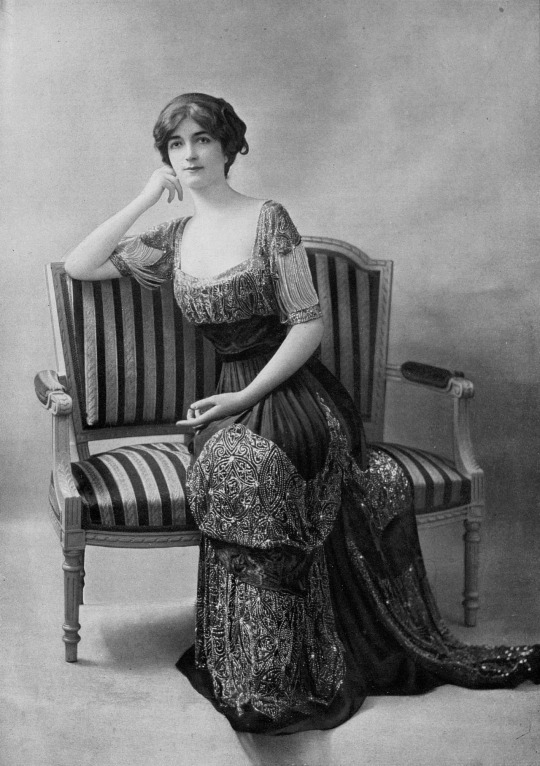

Left 1910 (May) Les Modes Evening gown by Bernard, photo by Félix. From les-modes.tumblr.com/search/1910s; abated streaks & fixed spots w Pshop 1280X1811.
Right 1910 (May) Les Modes Evening gown by Laferriére. .From les-modes.tumblr.com/search/1910s/page/13 1000X1393.

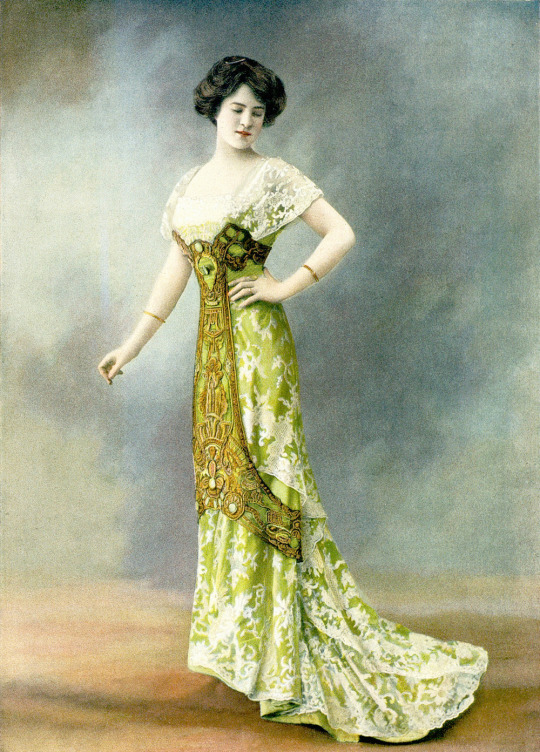
Left. 1910 Baroness Gerda von Chappuis (Mrs F. A. Konig) by Sir John Lavery (auctioned by Christie's) From the discontinued Athenaeum Web site; cropped 679X980.
Right. 1910 Evening dress by ? (location ?). From sartorialadventure.tumblr.com 360X1200.


Left 1910 Evening dress by ? (location ?). From sartorialadventure.tumblr.com 709X1400.
Right 1910 Evening dress by House of Worth (location ?). From costumehistory.tumblr.com/post/180312871593/shewhoworshipscarlin-evening-dress-by-house-of 1280X1679.


Left 1910 Lady by Arthur von Ferraris (auctioned by Michael Zeller). From Wikimedia 714X1003.
Right 1910 Marie Cécile Ney d'Elchingen (1867-1960), wife of Joachim, 5th prince Murat by Giovanni Boldini (auctioned by Christie's). From their Web site 1718X3212.
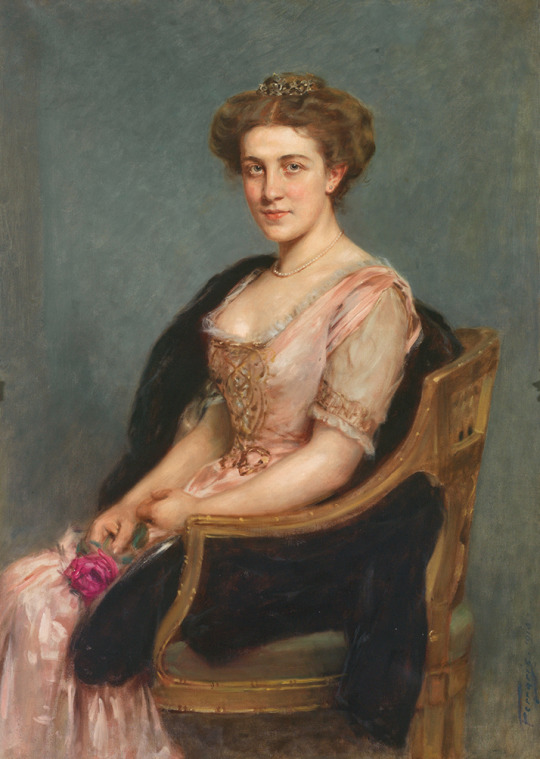

Left 1910 Mrs. E. L. Doyen by Giovanni Boldini (private collection). From arthive.com/sl/artists/8960~Giovanni_Boldini/works/270437~Portrait_of_Madame_Doyen 1765X3600.
Right 1910 Mrs. Mabel Brooks of Kinmount by Sir Hubert von Herkomer (auctioned). From pinterest.com/ustava51/живописьженский-образ/ 1187X1920.
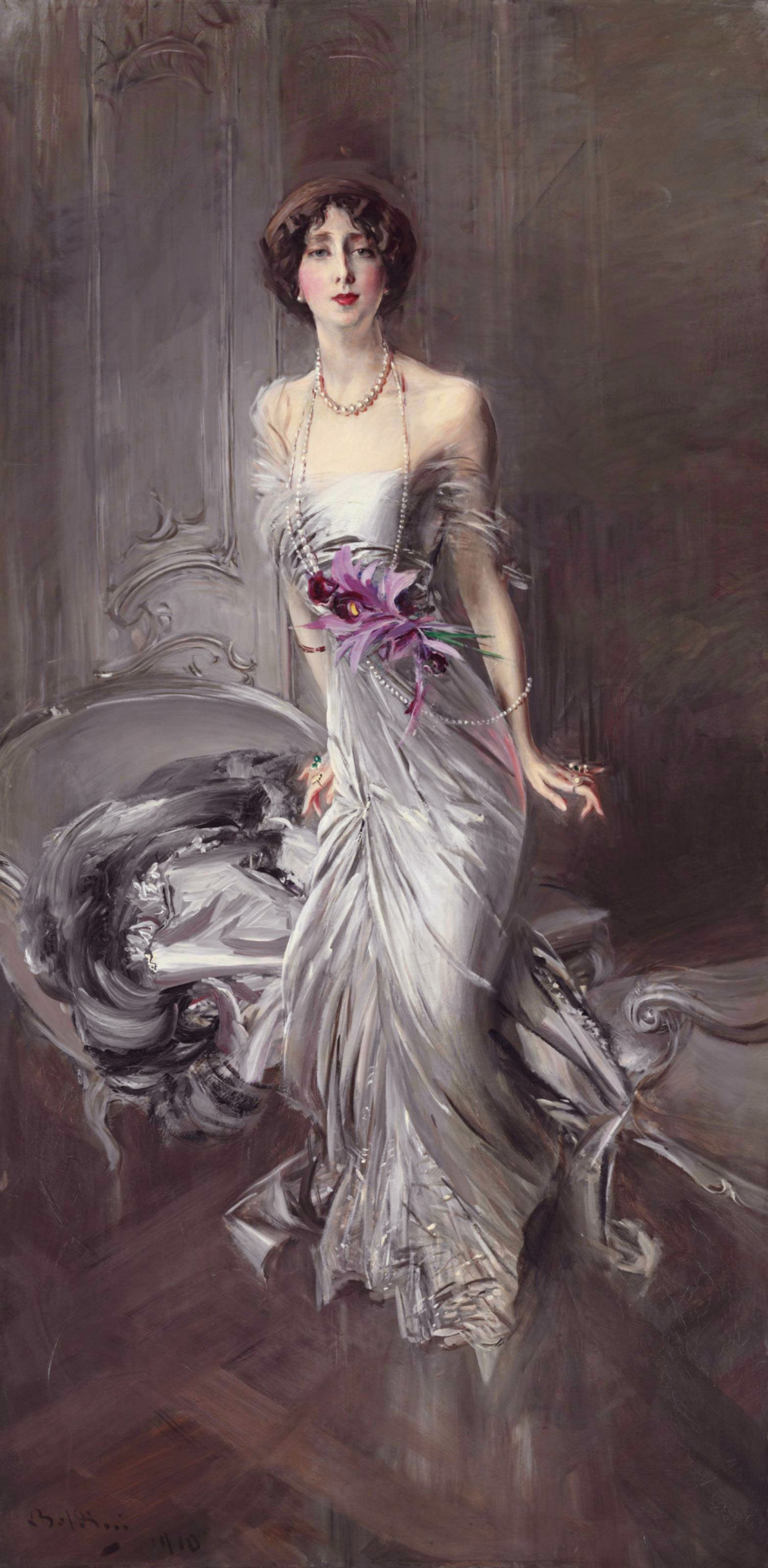
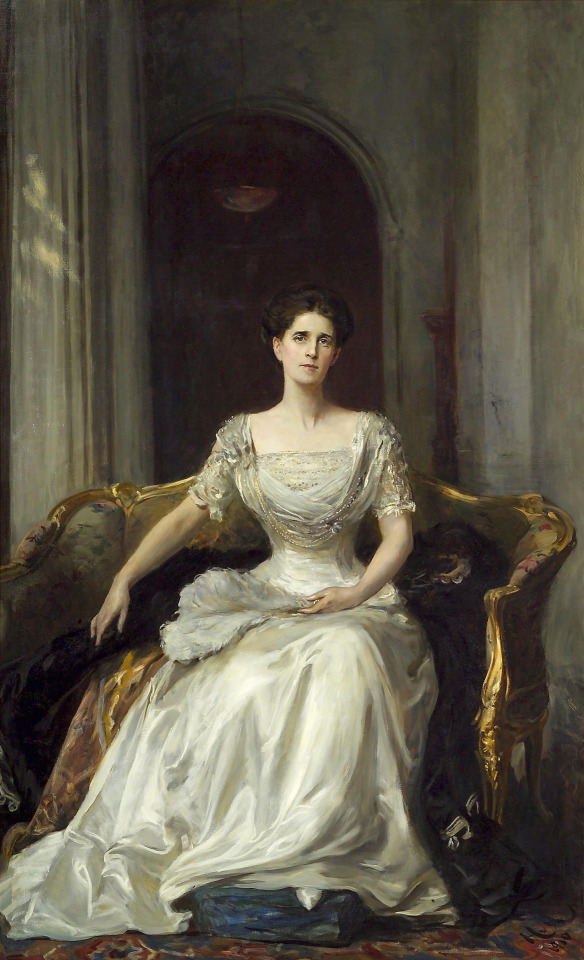
Left 1910 Peacock dress by ? (Metropolitan Museum of Art - New York City, New York, USA). From buzzfeed.com/deesims/10-stunning-gowns-to-reaffirm-the-belief-you-were-n5qq 638X1681.
Right 1910 Queen Mary photo signed May Posted to Foro Dinastias by Maravilha on 7 August 2010 1160X1600.


ca. 1910 Madame Duchesse Vendome and Prince Charles-Philippe d'Orléans by Boissonnas & Taponier. From eBay; fixed spots and removed mono-color tint 669X1067.

#1910s fashion#1910 fashion#Belle Époque fashion#Edwardian fashion#evening dress#dinner dress#Auguste Beer#Félix#close skirt#wide feathered hat#Maison Agnès#Drecoll#Reutlinger#Rivain & Cie#Augusta Bernard#Madeleine Laferrière#Gerda von Chappuis#John Lavery#House of Worth#Arthur von Ferraris#Marie Cécile Ney d'Elchingen#Giovanni Boldini#Mrs. E. L. Doyen#Mrs. Mabel Brooks of Kinmount#Hubert von Herkomer#Queen Mary#May of Teck#duchesse de Vendome#Boissonnas & Taponier#Jean-Charles Worth
68 notes
·
View notes
Text
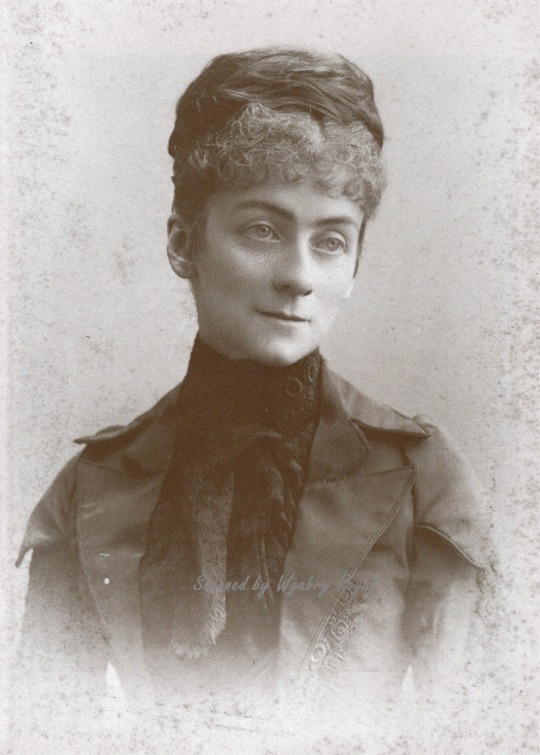
Duchess Sophie Charlotte Augustine in Bavaria wife of Ferdinand Philippe Marie d'Orléans, duc d'Alençon
Source "Das Familienalbum von Kaiser Franz Joseph und Elisabeth"
16 notes
·
View notes
Text
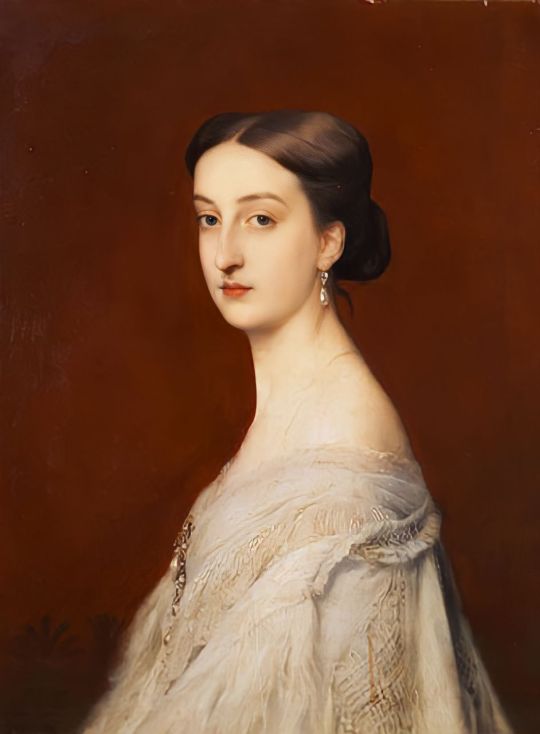
La Comtesse de Paris by Charles Jalabert.
Princess Marie Isabelle of Orléans (1848–1919) was born an infanta of Spain and a Princess of Orléans and became the Countess of Paris by marriage.
She was born in Seville to Prince Antoine, Duke of Montpensier and Infanta Luisa Fernanda of Spain.
She married her cousin Philippe d'Orléans, claimant to the French throne as Philippe VII and had eight children.
#royaume de france#maison d'orleans#bourbon orleans#comtesse de paris#infantes de españa#infanta de españa#bourbon montpensier#charles jalabert#Charles François Jalabert#marie-isabelle d'orléans#marie isabelle d'orleans#countess of paris#house of bourbon
31 notes
·
View notes
Text

Meeting on the Isle of Pheasants, originally represented in a tapestry by Charles Le Brun, later copied on oils by Jacques Laumosnier.
Y al regresar a Fuenterrabía diría a los señores de su séquito:
«—Vengo muerto, porque de ver llorar a mi hija, eso allá lo debía;
mi hermana también; pero cuando he visto estos dos muchachos
pendientes de mi cuello llorar como niños, me he de tal suerte
enternecido, que no puedo más».
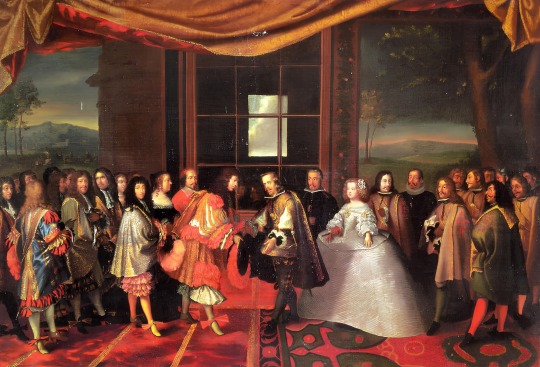

#i dont tag the spaniard philip anymore bc spaniards scare me#visual#habsburg#OMG NOT TAGGING HIM ON MY HYPERFIXATION BLOG#thats another level of pussy#louis xiv#bourbon#i heard the spanish painter (im not tagging him neither) also was on this meeting but im not sure if he is on the painting#tw the spanish painter with the v#anyway#philippe duc d'orléans#marie-thérèse d'autriche#cardinal mazarin#anne d'autrice#text
1 note
·
View note